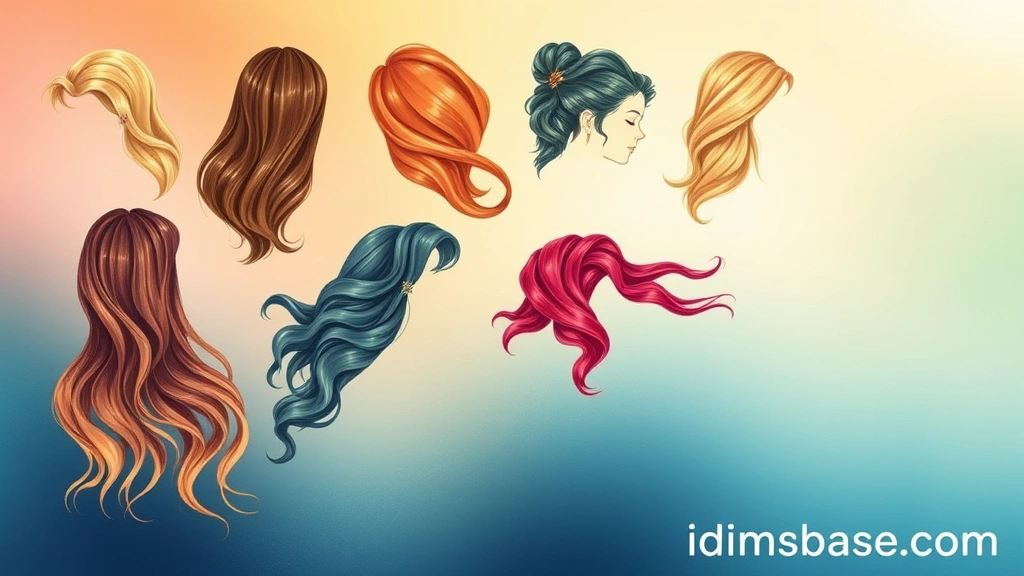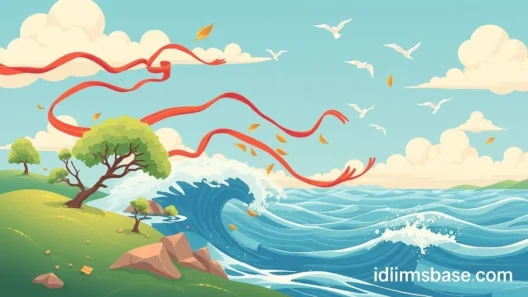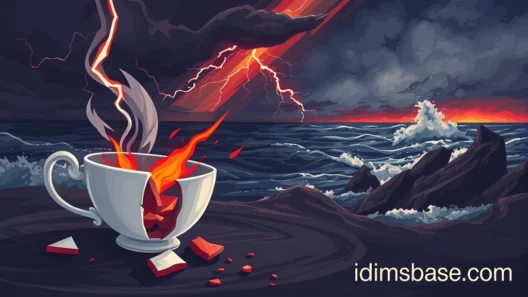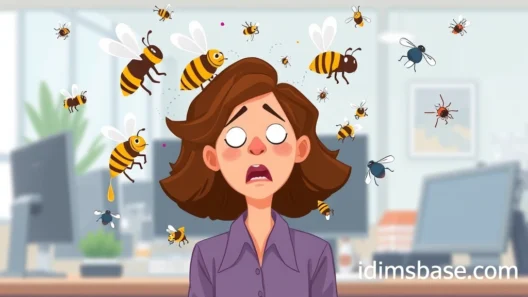Isn't it fascinating how a simple strand of hair can inspire so much poetry, so much imagery? From ancient myths to modern-day expressions, hair has always been more than just keratin and pigment. It's a canvas for identity, a symbol of strength, a whisper of rebellion, or even a cascade of secrets. We use metaphors for hair all the time, often without even realizing it. They help us paint vivid pictures with words, bringing our descriptions to life!
Have you ever stopped to think about how many different ways we describe hair? It's not just "long" or "short," "blonde" or "brown." We dive deeper, tapping into our imagination to find just the right words that capture its essence. And that's where metaphors come in! They allow us to compare hair to something else entirely, creating a powerful, often beautiful, connection in our minds.
In this exciting journey, we're going to explore 38 incredible metaphors for hair. Get ready to unlock new ways of seeing and describing those beautiful locks, whether they're yours or someone else's! You'll be amazed at the creativity and depth that these comparisons offer.
38 Metaphors for Hair: Unveiling Poetic Descriptions
Let's dive into the wonderful world of hair metaphors! Each one offers a unique perspective, inviting you to see hair in a fresh, imaginative light.
Hair as Nature's Wonders
- A cascade of silk: Imagine how silk flows and shimmers. This metaphor perfectly captures hair that is smooth, shiny, and falls gracefully. It evokes a sense of luxury and softness.
- A river of gold: For blonde or golden-hued hair, this metaphor paints a picture of dazzling movement and richness. It suggests hair that catches the light beautifully.
- A raven's wing: Dark, glossy, and mysterious, like the feathers of a raven. This is perfect for deep black hair with a beautiful sheen.
- A storm cloud: Think of dark, voluminous, perhaps unruly hair. This metaphor suggests power, drama, and a touch of wildness. It's truly captivating.
- A halo of moonlight: For very light, almost ethereal hair, this metaphor suggests a soft, glowing aura. It's delicate and enchanting.
- A forest of curls: When hair is densely curled, it can resemble a thick, untamed forest. This implies volume, texture, and a touch of wild beauty.
- A tumbleweed: For dry, tangled, or windblown hair, this metaphor perfectly conveys a sense of wildness and perhaps a bit of disarray.
- A spider's web: Fine, delicate strands, perhaps catching the light in a subtle way. This can suggest fragility or intricate beauty.
- A lion's mane: For thick, wild, and voluminous hair, often reddish or golden. This metaphor evokes strength, majesty, and untamed power.
- A desert of sand: For light, fine, and perhaps windswept hair. It can suggest a vastness or a certain dryness, depending on the context.
- A waterfall of ebony: Similar to a cascade, but specifically for very dark, flowing hair. It emphasizes depth and richness.
- A field of wheat: For light brown or golden hair, particularly if it's long and flows with movement. It brings to mind warmth and natural beauty.
- A silver thread: For a single strand of gray or white hair, often seen as a sign of wisdom or aging. It's a delicate and poignant image.
- A cloud of cotton candy: For very light, fluffy, and voluminous hair, suggesting softness and a playful quality.
- A thicket of brambles: For hair that is tangled, unruly, and perhaps a bit difficult to manage. It conveys a sense of wildness and resistance.
- A summer meadow: For hair that is a mix of colors, perhaps with highlights, evoking the natural beauty and variety of a meadow.
Hair as Textures and Materials
- A rope of braids: When hair is braided tightly, it can resemble a strong, coiled rope. This metaphor suggests strength and intricacy.
- A crown of thorns: For spiky, short, or perhaps rebellious hair, this metaphor suggests a challenging or edgy look. It's a powerful statement.
- A velvet curtain: For dark, soft, and luxurious hair that drapes beautifully. It evokes richness and elegance.
- A spun gold: For very fine, shimmering golden hair, suggesting something precious and meticulously crafted.
- A wire brush: For hair that is coarse, stiff, or perhaps standing on end. This metaphor highlights texture and rigidity.
- A silk ribbon: For hair that is smooth, flowing, and elegant, much like a beautiful ribbon.
- A bundle of hay: For dry, straw-like, or unkempt hair. This metaphor is often used humorously or to describe neglected hair.
- A tapestry of strands: This metaphor emphasizes the intricate weaving of individual hairs, creating a rich and complex whole.
- A living halo: For hair that seems to glow or have a life of its own, often used for very healthy, vibrant hair.
Hair as Abstract Concepts and Feelings
- A whisper of secrets: For hair that is fine, delicate, and perhaps covers part of the face, suggesting mystery and intimacy.
- A banner of defiance: For hair that is boldly colored, styled, or worn in a way that expresses individuality and rebellion.
- A veil of mystery: For hair that partially obscures the face, adding an element of intrigue and allure.
- A testament to time: For hair that shows signs of aging, such as graying or thinning, reflecting the passage of years.
- A sculpture of style: For hair that is meticulously styled and shaped, seen as a work of art.
- A crown of glory: For hair that is seen as beautiful, impressive, and a source of pride. This is a classic and powerful metaphor.
- A shield of confidence: For hair that is worn in a way that makes the person feel strong and secure.
- A canvas of expression: For hair that is frequently changed in color or style to reflect personality or mood.
- A wild untamed spirit: For hair that is naturally voluminous, curly, or resists conventional styling, reflecting a free personality.
- A marker of identity: For hair that is deeply connected to a person's cultural background or personal sense of self.
- A story in strands: Each strand, each color, each style tells a part of a person's journey and experiences.
- A whisper of the wind: For hair that is light, fine, and moves easily with the slightest breeze, suggesting freedom and lightness.
- A fountain of youth: For hair that retains its vibrancy, color, and thickness, defying the signs of aging.
Why Use Metaphors for Hair?
You might be thinking, "Why go through all this trouble when 'long brown hair' gets the point across?" And that's a fair question! But here's the thing: metaphors do so much more than just describe.
Enhancing Description and Imagery
Metaphors paint vivid pictures in the reader's mind. Instead of just "curly hair," imagine "a forest of curls." See the difference? One is factual, the other transports you! They add depth and richness to your writing, making it more engaging and memorable.
Evoking Emotion and Mood

A "storm cloud" of hair evokes a very different feeling than "a halo of moonlight." Metaphors allow you to convey emotions, personalities, or even the atmosphere of a scene through hair descriptions. They add layers of meaning that simple adjectives can't quite capture.
Adding Creativity and Originality
Using metaphors sets your writing apart. It shows creativity and a mastery of language. Instead of relying on clichés, you're crafting unique and impactful descriptions that resonate with your audience. You're inviting them into a more imaginative world.
SEO Benefits of Rich Language
Believe it or not, using rich, descriptive language with metaphors can also indirectly help your SEO! When people search for more evocative descriptions or look for creative writing examples, your content, with its beautiful metaphors, is more likely to stand out. It demonstrates quality and depth, which search engines appreciate.
How to Choose the Perfect Hair Metaphor
With so many options, how do you pick the right one? It's all about context and connection!
Consider the Hair's Characteristics

- Color: Is it like "a river of gold" or "a waterfall of ebony"?
- Texture: Is it "a cascade of silk" or "a wire brush"?
- Volume: Is it "a lion's mane" or "a whisper of secrets"?
- Style: Is it "a rope of braids" or "a sculpture of style"?
Think About the Person's Personality
Does their hair reflect a "wild untamed spirit" or "a shield of confidence"? The metaphor should align with the character or person you're describing. This adds another layer of meaning and makes your description more powerful.
Match the Overall Tone
Are you aiming for something poetic and romantic, or something humorous and lighthearted? A "crown of glory" fits a grand narrative, while "a bundle of hay" might be used for comedic effect. Your metaphor should always complement the overall tone of your writing.
FAQs About Hair Metaphors
You've got questions, we've got answers! Let's clear up some common thoughts about these fascinating linguistic tools.
Q1: What's the difference between a metaphor and a simile for hair?

A: Great question! The core difference is how they make the comparison.
- Metaphor: States that hair is something else. For example, "Her hair was a raven's wing." (Hair IS a raven's wing). It creates a direct equivalence.
- Simile: States that hair is like or as something else. For example, "Her hair was like a raven's wing." (Hair is LIKE a raven's wing). It uses "like" or "as" to draw the comparison.
Both are figures of speech that add imagery, but metaphors are generally more forceful and direct.
Q2: Can I use more than one metaphor for hair in a description?
A: Absolutely, but with caution! Using multiple metaphors can be very effective if they complement each other and build on the same idea. For example, "Her hair, a waterfall of ebony, felt like a velvet curtain against my cheek." Here, both metaphors reinforce the idea of dark, luxurious hair. However, avoid mixing too many disparate metaphors, as it can confuse the reader. Focus on clarity and impact.
Q3: Are there any metaphors for baldness or thinning hair?
A: Yes, there are! While this article focuses on hair that is present, metaphors can certainly be used for its absence or reduction. For example:
- A polished dome: For a shiny bald head.
- A lunar landscape: For a head with very sparse hair, showing the scalp.
- A receding tide: For a hairline that is moving back.
- A whisper of former glory: For very thin hair where once there was much more.
These metaphors can also be quite poignant or humorous depending on the context.
Q4: How do metaphors help with emotional connection in writing?
A: Metaphors bypass direct description and tap into shared human experiences and imagery. When you say "a storm cloud" of hair, you're not just describing dark, voluminous hair; you're also evoking feelings associated with a storm – power, drama, perhaps even a sense of impending change. This emotional resonance makes the description more memorable and allows the reader to connect more deeply with the character or scene. It's about showing, not just telling.
Q5: Can these metaphors be used in everyday conversation?
A: Definitely! While some are more poetic, many can be easily incorporated into casual conversation to make your descriptions more lively and interesting. Instead of saying "Her hair is really messy," you could say, "Her hair is a bit of a tumbleweed today!" It adds a touch of humor and personality to your speech. Using metaphors naturally makes you a more engaging communicator.
Key Takeaways
Wow, we've covered a lot of ground exploring the wonderful world of hair metaphors! Let's quickly recap the main points you can take away from this journey:
- Hair is More Than Just Hair: It's a powerful symbol, a canvas for self-expression, and a rich source of inspiration for creative language.
- Metaphors Paint Pictures: They transform simple descriptions into vivid, imaginative imagery that deeply engages the reader.
- Variety is Key: We explored 38 unique metaphors, categorizing them by nature, texture, and abstract concepts, showing the immense range of possibilities.
- Beyond Description: Metaphors don't just describe; they evoke emotions, convey mood, and add layers of meaning to your writing.
- Enhance Your Writing: Using metaphors makes your language more creative, original, and impactful, helping your content stand out.
- Choose Wisely: The best metaphor fits the hair's characteristics, the person's personality, and the overall tone of your narrative.
- Simile vs. Metaphor: Remember the key difference: metaphors state "is," while similes use "like" or "as." Both are powerful!
Ready to Weave Your Own Word Tapestry?
Now that you're armed with a treasure trove of hair metaphors, aren't you excited to start using them? Whether you're writing a novel, crafting a blog post, or simply describing a friend's new hairstyle, these metaphors offer a fantastic way to elevate your language.
Don't be afraid to experiment! Play with different comparisons, see what resonates, and let your creativity flow. Your words have the power to paint incredible pictures, and with these metaphors, you're well on your way to becoming a master of descriptive language.
Which of these metaphors resonated most with you? Do you have a favorite one that wasn't on our list? We'd love to hear your thoughts and see how you use these beautiful linguistic tools. Share your own hair metaphors in the comments below – let's inspire each other!






